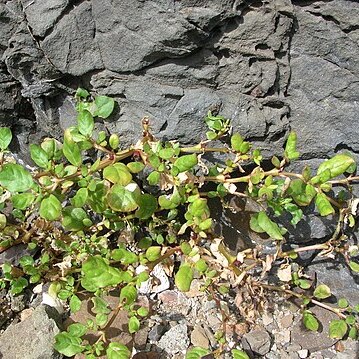Herbs [shrubs], annual or perennial, glabrous, hairy, or papillate. Roots fibrous. Stems usually prostrate, spreading, branched from base, sometimes woody. Leaves cauline, subopposite, petiolate, those of each pair unequal; stipules attached to margin of petiole, bidentate, usually papery; blade terete or flat, linear to orbiculate, base tapered, margins entire. Inflorescences axillary, flowers solitary or in cymes; bracts foliaceous; bracteoles 2. Flowers inconspicuous, 4 mm diam.; calyx lobes 5, adaxial surface colored, with subapical, abaxial, mucronate appendages; petals and petaloid staminodia absent; stamens perigynous, 5-10[-20], when 5, alternating with calyx lobes; pistil 2-carpellate; ovary superior, 1-2-loculed; placentation basal; ovules 1-12; styles 1-2, longitudinally papillate; stigmas 2. Fruits capsules, dehiscence circumscissile near base; operculum flat, ovoid, or globose, winged or mucronate. Seeds 1-12, brown to black, ridged, triangular, globose, or reniform, smooth or papillate; arils elongate.
Prostrate or diffuse herbs, glabrous, papillose or hairy, sometimes woody at base. Leaves opposite, unequal, entire, terete, linear or flat; petiole dilated at base. Flowers solitary or clustered, axillary, sessile or pedicellate, each subtended by one or more scarious bracts. Perianth of 5 shortly-fused segments; lobes unequal with scarious margins, sometimes with a dorsal mucro behind apex, coloured inside. Stamens 5 to many, adnate to upper edge of perianth tube; staminodes absent. Ovary superior; style and locule 1; ovules 2 to many; placentation basal. Fruit a capsule, membranous or woody, circumsciss usually near base, the upper part (operculum) flat, ovoid, or subglobular; perianth usually persistent. Seeds 1 to many, triangular, reniform or comma-shaped, smooth or patterned, often papillose, black.
Herbaceous or suffruticose plants, branched, upright or prostrate. Leaves simple, opposite, strikingly unequal, fleshy, obovate to rounded-spatulate, the petioles connate into a petiolar sheath surrounding the stem; stipulate. Inflores-cences axillary, cymose or the flowers solitary. Flowers bisexual, sessile or pedicel-late. Perianth 5-parted, connate below, the lobes appendaged on the outer surface beneath the apex, imbricate. Stamens 5 or more, inserted on the perianth tube or free and monadelphic. Ovary superior, 1-or 2-loculate, the ovules campylo-tropous, few on the axile placenta, the styles 1 or 2. Capsule circunmscissile; seeds few, reniform, the testa often wrinkled, estrophiolate.
Herbs annual to perennial. Stems procumbent to ascending, often much branched. Leaves opposite, entire, those of a pair unequal, terete to flat, petiole broadening at base forming a sheath around stem. Inflorescences of solitary or clustered flowers subtended by scarious bracts and bracteoles. Flowers sessile or pedicellate. Perigone tube campanulate, short to long, smooth to hairy; lobes 5, inside white, green, or pink to purple, outside fleshy. Stamens 5 to many, adnate with perigone. Perigynous, ovary with a truncate or impressed apex, 1-loculed; stigma 1. Capsule terete or turbinate, operculum with 1 or 2 seeds falling off as a whole. Seeds globose-reniform to lentil-shaped.
Procumbent diffuse glabrous, papulose, or pubescent succulent mostly annual herbs. Leaves opposite, those of a pair often unequal, linear to almost orbicular, entire, petiolate or sessile. Leaf-bases membranous-dilated, often connate in pairs and with small stipuliform lobes. Flowers axillary, solitary, fascicled or glomerulate, free or connate, sessile or stalked. Calyx gamosepalous, 5-lobed; lobes usually with a distinct subapical dorsal mucro. Stamens 5-many, episepalous, when definite alternate with the calyx-lobes. Ovary of one carpel, unilocular, apex truncate or depressed around the style; ovules and seeds 2-many; placentation parietal.
Fls perfect, perigynous; sep 5, each usually with a dorsal appendage near the tip; pet none; stamens mostly 5–10; ovary unilocular or bilocular, with accordingly 1 or 2 styles; ovules few; capsule circumscissile; seeds arillate; succulent, shortly taprooted herbs with opposite lvs basally connate into a short sheath with interpetiolar stipules; fls small, solitary or few in the axils. 20, warm reg.
Leaves opposite, those of a pair often unequal, linear to almost orbicular, entire, petiolate or sessile; leaf-bases membranous, dilated, often connate in pairs and with small stipuliform lobes.
Prostrate, procumbent, ascending or erect, glabrous, papillose or pubescent, succulent, mostly annual herbs; stems with long often unequal internodes.
Fruit circumscissile, enclosed by the perianth, the lid ± truncate, with thickened bands, the apex thin and often depressed.
Perianth segments distinctly united at base into a tube, the lobes ascending, mucronate behind the tip.
Stamens 5–?, attached to the perianth, when definite alternate with the perianth lobes.
Flowers axillary, solitary or more often in groups, free or connate, ± sessile.
Ovary of 1 carpel, 1-locular, with 2–? ovules; placentation parietal.
Seeds 2–?.

